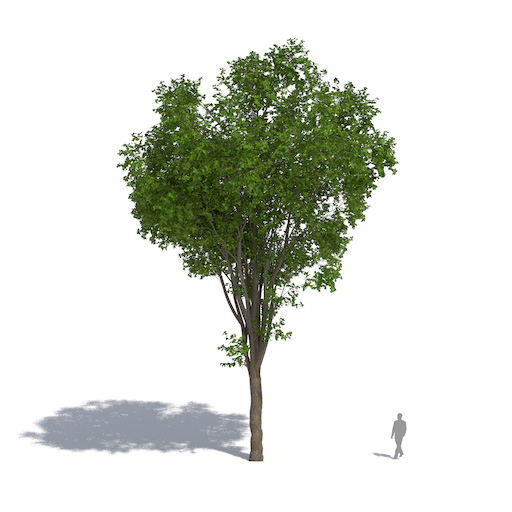Beschreibung
The following 10 tree species are included in the Plants Kit 10. Each species comes in 36 variations per species, i.e. 3 variants, 3 ages and 4 seasonal aspects, for a total of 360 models per Kit.
Southern catalpa
Catalpa bignonioides
Medium-sized, deciduous, spreading tree with an irregular, broad-rounded crown. Grey or yellowish to reddish brown bark. Large, broad-ovate, pale green leaves, pubescent below, opposite, or in threes. Short-pointed at the tip and rounded or heart-shaped at the base. Very ornamental, bell-shaped, fragrant, white flowers with purple and yellow inner markings bloom in late spring in many-flowered upright panicles. Fruit a long, slender bean-like green pod that matures to dark brown in autumn.
Voss’s laburnum
Laburnum x watereri ‘Vossii’
Small deciduous tree with a vase-shaped crown. Olive grey bark, darker with some roughness and fissuring on mature trunks. Alternate leaves composed of three leaflets. Spring leaves are bright green, mature leaves glabrous and blue-green turning yellow-green in autumn. Lavish display in late spring of long, drooping racemes of bright yellow, pea-shaped, fragrant flowers. Poisonous seeds. It has gained the Royal Horticultural Society’s Award of Garden Merit.
Tulip tree
Liriodendron tulipifera
Large, stately, deciduous tree with a pyramidal to broad conical habit. Column-like trunk with brown, furrowed bark. Four-lobed leaves, heart-shaped or truncate or slightly wedge-shaped at base. Bright green leaves turn golden yellow in autumn. Cup-shaped, tulip-like flowers, yellowish-green, marked with orange within bloom in late spring. Scaly, oblong, cone-shaped brown fruits. State tree of Kentucky, Tennessee and Indiana.
Persian ironwood
Parrotia persica
Small- to medium-sized deciduous tree or large shrub with a wide-spreading habit, often multi-stemmed. Smooth, pinkish-brown bark. Bark of mature trees exfoliates to leave attractive patches of cinnamon, pink, green, and pale yellow beneath. Broadly ovate leaves, alternately arranged, emerge reddish-purple in spring, mature to a lustrous, medium to dark green in summer, and change to variable shades of yellow, red and purple in autumn. Small but abundant crimson flowers on bare twigs in late winter and early spring.
Foxglove tree ‘Lilacina’
Paulownia tomentosa ‘Lilacina’
Fast-growing, medium-sized, deciduous tree with an upright to spreading, rounded crown. Thin, grayish brown bark with shallow fissures. Ovate or shallowly-lobed, large green leaves, slightly hairy above and densely hairy beneath. No autumn color. Profuse bloom of very fragrant, trumpet-shaped, pinkish-lavender flowers, which appear in mid spring in large panicles before the foliage. Fruits are oval, wood seed capsules that emerge green and ripen to brown in autumn. Spectacular tree primarily grown for its profuse spring bloom of foxglove-like flowers and its large catalpa-like green leaves. It has gained the Royal Horticultural Society’s Award of Garden Merit.
London plane
Platanus x hispanica
Majestic large, fast-growing, deciduous tree, initially with a broadly conical, then extensive and with round crown. Attractively patterned bark, usually pale grey-green, smooth and exfoliating bark. Medium to dark green leaves are thick and stiff-textured, broad, palmately lobed, maple-like. The young leaves in spring are coated with fine stiff hairs at first, but by late summer the leaves are (nearly) hairless and turn a pale yellow-brown in autumn. Inconspicuous flowers. Clustered, burr-like fruits, which persist throughout winter. The original cross between Platanus occidentalis and Platanus orientalis may have occurred in the 17th century, after which this tree became widely planted in London and other major European cities because of its tolerance for urban pollution.
Yoshino cherry
Prunus x yedoensis ‘Somei-yoshino’
Small, deciduous tree with a spreading, broad-rounded, open crown. Dark reddish-brown bark. Elliptic to oval, serrate, dark green leaves, alternately arranged, turning yellow and with bronze tints in autumn. Fragrant white or tinged pink flowers in clusters appear before or simultaneous to the emergence of the foliage in a profuse and spectacular early spring bloom. Small black cherries, loved by birds. One of the most widely planted of flowering cherry trees in Japan today. It is considered one of the most spectacular of flowering temperate trees in cultivation.
Pin oak
Quercus palustris
Medium-sized, fast-growing, deciduous tree with a columnar trunk and a broad pyramidal crown in youth, matures to a loose, spreading canopy. Smooth gray-brown bark usually develops ridging on mature trunks. Glossy, dark green leaves typically have five bristle-tipped lobes turning reddish-brown or bright crimson in autumn. Inconspicuous flowers. It is perhaps the most popular oak of eastern North America.
Sassafras
Sassafras albidum
Small to medium-sized deciduous tree with an upright habit, shrubby in youth, matures to a dense, pyramidal tree. Reddish brown bark on young branches, thick, dark red-brown, and deeply furrowed on mature trunks. Glossy aromatic leaves in three shapes (unlobed elliptical, two-lobed, and three-lobed), bright green above and glaucous below. Leaves turn to yellow, purple and red. Attractive but quite inconspicuous greenish-yellow flowers appear in clusters at the branch ends in early spring shortly before the leaves. Male and female flowers are carried on separate trees.
American elm
Ulmus americana
Medium to large, fast-growing, deciduous tree with a vase-shaped crown and a spreading umbrella-like canopy. Smooth, dark grey bark with deep ridges. Dark green simple leaves, alternately arranged, with double serrated leaf margins, typically turn an undistinguished yellow in autumn. Inconspicuous flowers, and fruits. American elm is one of New England’s most beautiful trees and was once before the Dutch elm disease a ubiquitous and monumental street tree.
















Bewertungen
Es gibt noch keine Bewertungen.